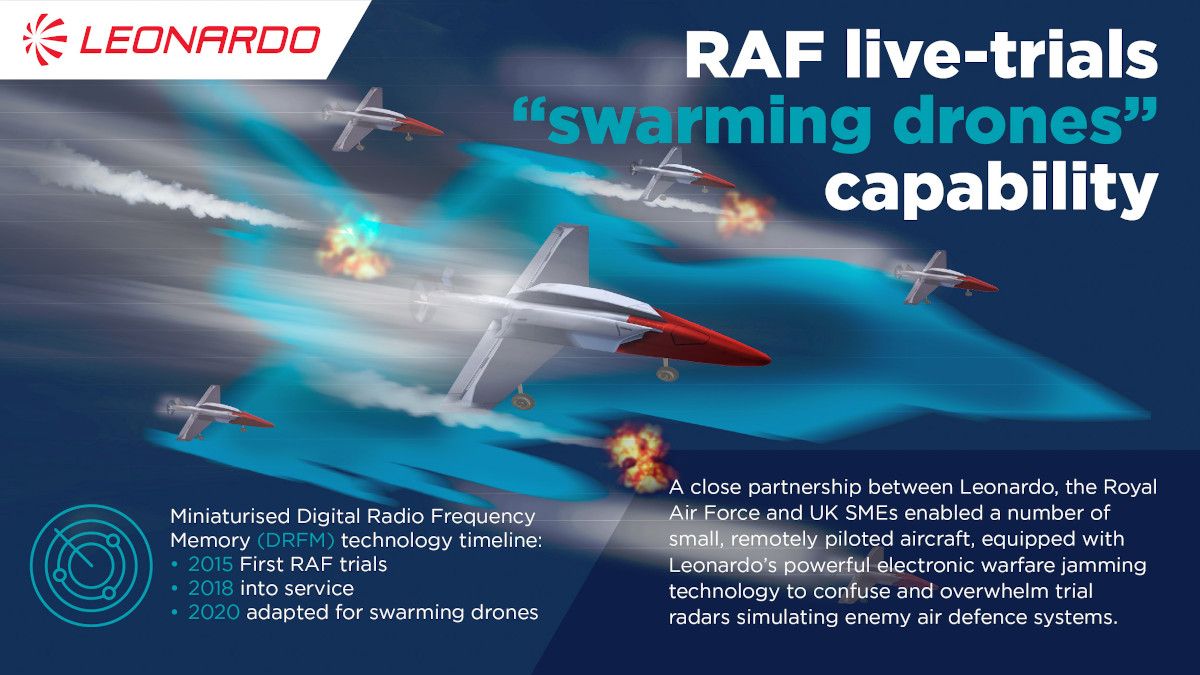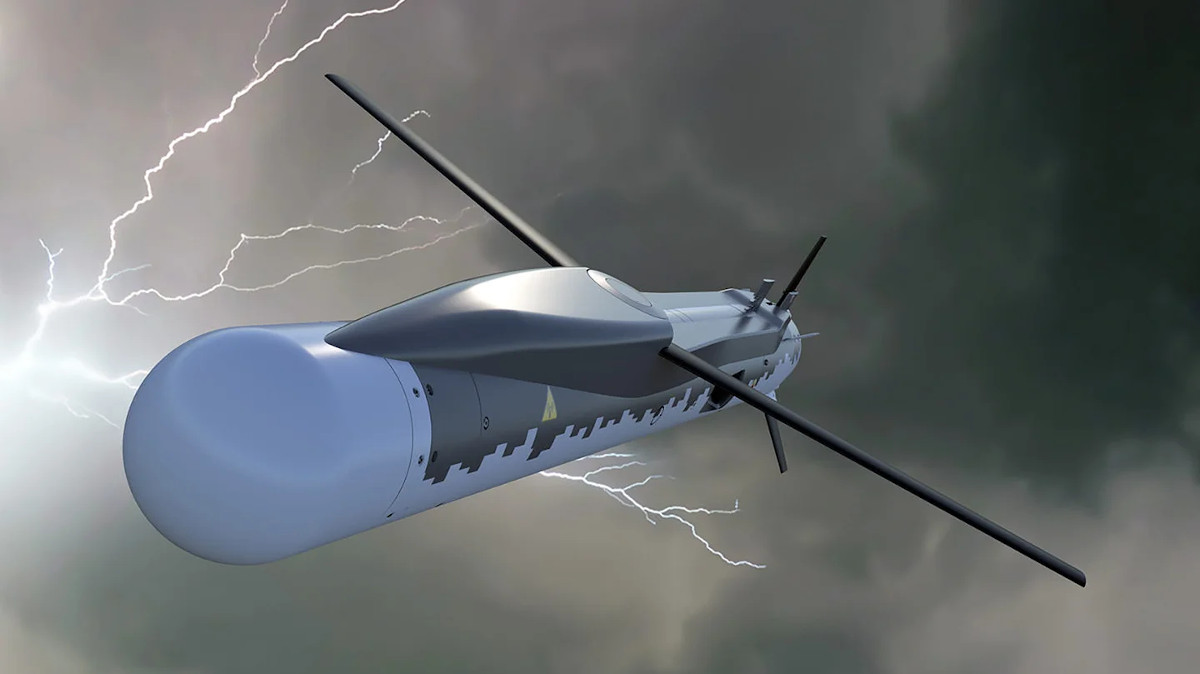Italian defense contractor Leonardo says that it has conducted a successful demonstration in cooperation with the U.K. Royal Air Force of an autonomous swarm of unmanned aircraft, each carrying a variant of its BriteCloud expendable active decoy as an electronic warfare payload. Using the BriteClouds, which contain electronic warfare jammers, the drones were able to launch a mock non-kinetic attack on radars acting as surrogates for a notional enemy integrated air defense network.
Leonardo announced it had carried out the swarm demonstration, which it conducted together with the Royal Air Force’s Rapid Capabilities Office (RCO), as well as private unmanned technology firms Callen-Lenz and Blue Bear, on Oct. 7, 2020. The latter two firms, as well as Boeing, are working on prototype semi-autonomous “loyal wingman” type drones for the RAF, which that service also refers to as “remote carriers,” as part of Project Mosquito, which is itself a component of the larger Lightweight Affordable Novel Combat Aircraft (LANCA) program.
“During the demonstration, a number of Callen Lenz drones were equipped with a modified Leonardo BriteCloud decoy, allowing each drone to individually deliver a highly-sophisticated jamming effect,” according to Leonardo’s press release. “They were tested against ground-based radar systems representing the enemy air defence emplacement. A powerful demonstration was given, with the swarm of BriteCloud-equipped drones overwhelming the threat radar systems with electronic noise.”
For reasons that are unclear, Leonardo has since removed its press release from its website, though an archived copy of the page remains available through Google. The company also deleted an official Tweet with an infographic, a copy of which is seen below, regarding BriteCloud and this demonstration.

Leonardo did not offer any details about the unmanned aircraft used in the demonstration. Artist’s conceptions of a drone swarm strike that the company released along with the announcement, seen at the top of this story and in the infographic above, showed a tailless fixed-wing design with a single, rear-mounted pusher propeller and fixed undercarriage. However, there is no indication one way or another if this in any way reflects the Callen-Lenz design employed in the recent test.
The standard BriteCloud is what is known as a Digital Radio Frequency Memory (DRFM) jammer that first detects incoming radar pulses from hostile platforms, including aircraft, ships, and ground-based air defense systems, as well as active radar guidance systems on incoming missiles. It then mimics those signals in return, creating the appearance of a false target. As Leonardo said in its own press release, this effect can “confuse and overwhelm” radars and lure missiles away from friendly aircraft.
BriteCloud, which can be launched from any dispenser capable of firing standard 55mm decoy flares or chaff cartridges, first entered RAF service in 2018 on the now-retired Tornado GR4 combat jet. Last year, the service began tests of the decoy on its Eurofighter Typhoons and indicated that it could also eventually integrate them on its F-35B Joint Strike Fighters.

Unlike a plane dropping expendable BriteClouds, in the recent demonstration, Leonardo noted that “the decoy packages were programmed and navigated to work collaboratively to cause maximum confusion.” Placing the jammers inside drones offers the ability to help space them out for optimal coverage across a wide area. The entire swarm provides immense additional flexibility by being able to rapidly shift its focus from one area to another to respond to new developments in the battlespace. Above all else, they allow BriteCloud to employ its bag of tricks over longer periods of time and even execute multiple electronic attacks instead of just one.
At the same time, the off-the-shelf electronic warfare expendables are just that, expendable. If you lose one and its drone platform, it isn’t a big deal as they are meant to be expendable in the first place. As such, they are the very definition of attritable. This term refers to designs that could be recovered and reused, but that are also cheap enough for commanders to be willing to commit them to higher-risk missions where there is a significant chance of them getting knocked down.
The RAF is not the only one to be looking at drone swarms, or otherwise networking munitions and other expendable stores together to reduce duplication of effort and otherwise improve the efficacy of strikes and other missions. The U.S. Air Force is in the midst of its own networked munition program, called Golden Horde, and the Army recently revealed plans to develop swarms of air-launched drones carrying electronic warfare systems and other payloads, efforts that you can read about in more detail in these past War Zone pieces.
The general idea of using an autonomous swarm of drones to blind, confuse, and overwhelm an enemy’s integrated air defense network, or other sensor and communication nodes, is hardly new, either and is one of the most common missions envisioned for such a group of unmanned aircraft. Carrying out such missions in the open stages of conflict would make good sense as they would help clear paths for other manned and unmanned aircraft, including more vulnerable, non-stealthy types, to conduct follow-on kinetic strikes or carry out other tasks, such as intelligence, surveillance, and reconnaissance (ISR).
Depending on the size and capability of the basic drones in the swarm, its possible that entire autonomous grouping could carry out multiple missions itself simultaneously, including ISR and kinetic strike. Stand-in expendable decoys, such as BriteCloud, could be combined with other non-kinetic options, such as existing and emerging standoff decoys and expendable electronic warfare systems, as well.
Last year, European missile consortium MBDA, of which Leonardo is a part, notably unveiled plans for a SPEAR-EW version of its SPEAR-3 miniature cruise missile. SPEAR-EW will carry an electronic warfare jammer, one that may well utilize technology from BriteCloud, instead of an explosive warhead. There has already been talk of networking SPEAR-EWs and SPEAR-3s together to carry strikes as their own kind of autonomous swarm. You can read more about SPEAR-EW and the concepts of operation surrounding it in more detail in this past War Zone piece.

This test also speaks to where the RAF in the United Kingdom is at developmentally when it comes to its drone swarm efforts, which it first unveiled plans for last year. The service established a dedicated unit to explore both loyal wingman and swarm concepts, 216 Squadron, this year, but the COVID-19 pandemic has slowed its expansion.
This demonstration of integrating BriteCloud into lower-end drones would certainly seem to offer a very viable path to a useful drone swarm capability for the RAF in the near term. It could be then combined it with higher-end, heavier unmanned aircraft capabilities as part of a broader swam strategy in the future, as well.
If nothing else, Leonardo’s demonstration in cooperation with the RAF highlights how drone swarms capable of carrying out a multitude of mission sets are moving ever closer to becoming a key component for future combat operations.
Contact the author: joe@thedrive.com
